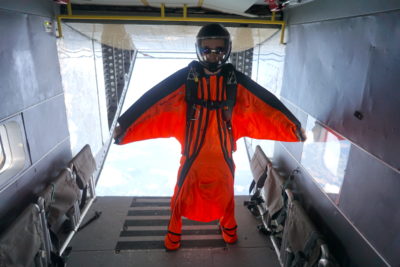If your primary exposure to skydiving is through box office films or even your own bucket-list tandem skydive experience, you may not realize how truly diverse the sport of skydiving is. Beneath the umbrella of general sport skydiving, there are many different niches. Within the industry, we call these niches skydiving disciplines and they represent the different avenues that any jumper can pursue. Here are a few of the most popular skydiving disciplines.
Formation Skydiving
Formation skydiving – colloquially known as belly flying – involves multiple skydivers who together create predetermined patterns during freefall by fulfilling a sequence of maneuvers. It’s among the most accessible skydiving disciplines for beginners because it requires some of the first skills you learn to achieve your A license. But don’t let that fool you into believing that formation skydiving is necessarily easy!
It’s not difficult to get into formation skydiving. To start, reference some formation diagrams and begin learning the basic formations. Then, gather your friends and create a dive flow by selecting a few formations to try out in the sky. Finally, plan the dive and dive the plan! You’re now a formation skydiver.
To get even more involved, check to see if there are any local formation skydiving competitions or camps near you! Competitive skydiving includes four skill-based levels: beginner, intermediate, advanced, and open. Open class formation skydiving is the most competitive discipline there is, and often, a winning team is decided by a mere fraction of a second.
Freefly Skydiving
Freefly skydiving is a skydiving discipline in which an individual flies in an orientation other than belly-to-earth. Typically, this means flying head up in a seated position (called sit flying) or flying head down.

Flying in these altered orientations with less drag means that freeflyers are often reaching speeds of 160 mph in freefall. With increased speed comes less margin for error, making freefly skydiving best reserved for more advanced skydivers. Safely pursuing freefly skydiving requires a bit of experience and some coaching. With the right training and a measured approach, freefly skydiving can be a lot of fun!
Angle Flying
Angle flying is a skydiving discipline that has grown in popularity significantly over the last decade. Angle flying is what we call a movement skydiving discipline. Rather than falling straight down on a vertical axis, angle flyers travel on a more horizontal axis across the sky.
Within angle flying, there are different degrees (see what we did there?) of movement. Beginner angle flyers will primarily fly horizontally and, as they progress, start to alter their pitch to fly more steeply – and advanced angle flyers will typically reach speeds of 200 mph! Some exceptionally advanced angle flyers can combine this discipline with some freefly principles in order to angle fly on their backs or in some cases, even in a head up standing orientation!
As a movement discipline, to minimize risk, angle flying requires proper preparation and a designated flight plan prior to the jump. To begin angle flying, one should perfect their horizontal tracking skills and work with an approved coach to begin flying at steeper angles. Jumpers will usually attend angle flying camps led by professional angle flying coaches in order to refine their skills.
Wingsuiting
Of the skydiving disciplines, wingsuiting is one of the most well-known outside of the skydiving community. Donning what non-skydivers often call “flying-squirrel suits,” wingsuit flyers glide about the sky using the added lift of material stretched between their wrist and hip, and between their legs.

Wingsuiting is not an introductory skydiving discipline. In fact, you must have completed 200 skydives and go through a wingsuit course before putting on a wingsuit. Eventually, as one gains experience and skill, s/he may begin flying in groups with others (called flocking) or begin experimenting with acrobatic moves like flips or barrel rolls. As a burgeoning skydiving discipline, there is much to learn and to explore with wingsuiting.
Canopy Piloting
Canopy piloting is commonly referred to as swooping. Canopy piloting swooping involves diving a parachute toward the ground to induce speed. By performing appropriate canopy maneuvers, the downward speed is translated into forward momentum which is then used to glide quickly across the ground.
As swooping is considered an advanced skill, anyone interested in canopy piloting should receive proper canopy instruction before attempting to swoop. This type of instruction can be found through an intermediate or advanced canopy course with an established organization like Flight-1 or Superior Flight Solutions.
Competitive Skydiving
Many new to skydiving are surprised to learn that competitions exist for all of the skydiving disciplines above with the exception of angle flying (for now). In fact, creating a team and participating in competitive skydiving is a great way to grow and improve your skills within the sport.
Which skydiving discipline will you choose? Regardless of where the sport takes you, there’s one step we all take: scheduling that first solo jump! Not ready to fly solo? It’s alright, get a taste of flight with a tandem skydive. Blue skies!
Copyright © 2025, Skydive Monroe, All Rights Reserved.
DropZone Web Design & Marketing by Beyond Marketing, LLC



